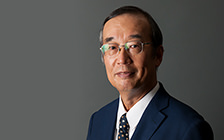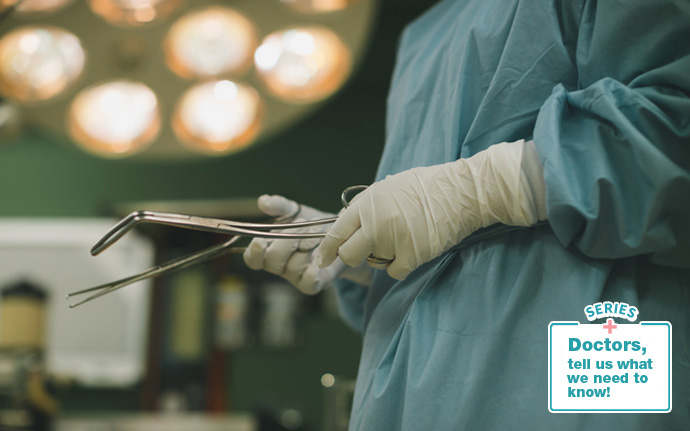
Goligher’s classification indicates the degrees of symptoms (prolapse) of hemorrhoids (piles). The degrees of hemorrhoids are largely classified into the following 4 grades: grade 1, bleeding but no prolapse; grade 2, prolapse through the anus on straining but reduced spontaneously; grade 3, prolapse through the anus on straining or exertion and require manual replacement into the anal canal; and grade 4, prolapse stays out at all times and is irreducible. Surgery is required for Grade 3 and 4 hemorrhoids. The standard surgical procedure for hemorrhoids is ligation and excision (LE). Currently, methods to cure internal hemorrhoids by injection have been widely used, and options such as day surgery have also expanded. Regarding cancer treatment, approaches that focus on cure of the disease are required and deviation from treatment guidelines may place patients at risk; however, proctology treatment is basically to remove symptoms patients are suffering from. At our clinic, we provide a patient with a medical diagnosis and determine the appropriate treatment method after consultation with the patient in consideration of the patient's daily life including work.
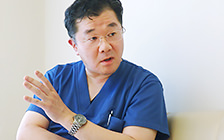
Ligation and excision (LE) is the standard surgical procedure for hemorrhoids (piles) because this is a highly curative surgery. However, there are risks of postoperative bleeding, pain, and anal stenosis. The “anal cushion lifting (ACL) technique” is performed at our clinic. It is said that hemorrhoids are caused by downward displacement and hypertrophy of tissues like a rubber stopper (anal cushions) which anatomically play a role in preventing anal leakage. This means that the portion of hemorrhoids (anal cushions) are necessary and should be “reverted to the original position” without being excised. This is the concept of "ACL technique." This technique can afford great pain relief causing almost no abnormality in anal function. It also causes almost no change in the appearance of the affected area because no excision is performed. The "ACL technique" is described in the Japanese Practice Guidelines for Anal Disorders published in 2014, and has become the main treatment in the past few years. However, since hemorrhoids are just reverted to the original position in the "ACL technique," recurrence is more likely after this technique than after surgical excision procedure. Therefore, patients must pay thorough attention to their lifestyle after undergoing the ACL technique. Lifestyle guidance is also provided for this purpose.

According to statistics at our hospital, approximately 25% of patients were diagnosed with hemorrhoids (piles) at the first visit and then underwent surgery. The hospitalization period is about 10 days for the standard surgical procedure of ligation and excision (LE). However, our hospital is located in Kagoshima and there are many patients visiting from isolated islands. Such patients cannot frequently visit the hospital and, thus, need to be hospitalized a little longer until the end of a postoperative critical period. The overall average hospitalization period is about 12 days. Surgical procedures and instruments have been improved year by year, with increased safety and substantially shortened surgery duration compared with the past. Currently, "aluminum potassium sulfate and tannic acid (ALTA) injection" is being widely used as sclerotherapy. This is a procedure in which external hemorrhoids are excised and internal hemorrhoids are treated by sclerosis injection. Since the extent of excision is half of the affected area, many hospitals in the central area of Tokyo perform ALTA sclerotherapy as outpatient surgery.
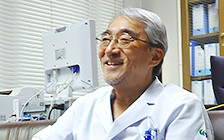
Patients who have first experienced anal bleeding or who have had sudden onset of external thrombosed hemorrhoids visit a hospital relatively soon. However, there are patients who experience prolapsed hemorrhoids repeatedly at every bowel movement and manually put them back in place. Such patients do not visit a hospital for years, during which time their condition gradually gets worse. At first, patients may experience mild prolapse in which only a part of hemorrhoids prolapses and reduces spontaneously; however, prolapsed hemorrhoids may progress and occur while patients have bowel movements or are doing sports, and even while they are walking. Prolapsed hemorrhoids cannot be treated by drugs, so it is recommended that patients visit a hospital early rather than continuing to reduce them manually. For small hemorrhoids, rubber band ligation therapy or injection sclerotherapy will be performed in outpatient settings. Radical surgery is hemorrhoidectomy, and if the affected area is completely excised, hemorrhoids (piles) are unlikely to recur.
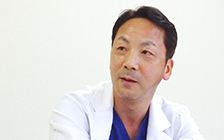
At our hospital, ointment or oral drugs are commonly used as the initial treatment of hemorrhoids (piles). The treatment of hemorrhoids is also associated with dietary habits, job demands, and other stressful things. At our hospital, we provide a set of instructions titled "10 Tips for Treatment and Prevention of Anal Diseases," so patients can improve their lifestyle as it relates to hemorrhoids. If there is no response to drug therapy for about one month, surgery will be considered. At our hospital, both ligation and excision (LE) and aluminum potassium sulfate and tannic acid (ALTA) therapy are in use. At our hospital, LE and ALTA therapy account for 70% and 30%, respectively, of all cases. The decision is made after consultation with the patient. The hospitalization period is 1 night and 2 days for ALTA therapy, and 1 week for LE. LE should be performed for complete cure; however, most working men choose ALTA therapy because they cannot be absent from work. On the other hand, many women choose LE for complete cure while taking a rest.
*ALTA therapy: Sclerotherapy for internal hemorrhoids in which hemorrhoids are sclerosed and shrunken by injection.
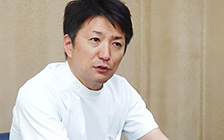
Internal hemorrhoids are a type of hemorrhoids (piles) that are located in the rectum 2 cm or deeper inside the anal canal. The surrounding tissue is innervated by autonomic nerves, not by sensory nerves, so it does not feel pain. Bleeding internal hemorrhoids that are not prolapsed involves only congestion and erosion on the surface of these hemorrhoids, and such hemorrhoids can be cured with ointments and/or suppositories. However, hemorrhoids which are prolapsed and swollen are difficult to treat with drugs, mostly requiring some surgical procedures, such as injection sclerotherapy and surgical incision. For external hemorrhoids, it is also useful to warm the affected area in a bath because most external hemorrhoids are just swollen, not prolapsed. It is recommended to consult a doctor if anal bleeding persists regardless of the types of hemorrhoids, internal or external hemorrhoids.
